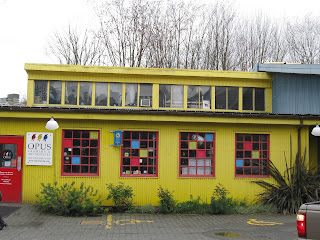 If you were to ask anyone who has experienced the excitement of Vancouver's Granville Island, the first word they think of, it is unlikely to be "brownfield development." Okay, that's two words, but you take my point.
If you were to ask anyone who has experienced the excitement of Vancouver's Granville Island, the first word they think of, it is unlikely to be "brownfield development." Okay, that's two words, but you take my point. Restaurants and waterfront bars, high end shops, parks, miles of sea wall walks, an art school, a community theatre, house boats and a yacht harbour, museums and marine stores, an incredibly diverse food and craft market, high density waterfront living on its doorstep - and did I mention industry? - all thrive, a short water-taxi hop from the residential west end and commercial downtown of Vancouver.
Restaurants and waterfront bars, high end shops, parks, miles of sea wall walks, an art school, a community theatre, house boats and a yacht harbour, museums and marine stores, an incredibly diverse food and craft market, high density waterfront living on its doorstep - and did I mention industry? - all thrive, a short water-taxi hop from the residential west end and commercial downtown of Vancouver.
This fascinating history link tells the whole story. Here's a precis. In the early 1900s, what is today's 38 acres of Granville Island was a mud flat that disappeared at high tide. But a bright light at the Vancouver Harbour Commission saw the potential of creating new land in (even then!) expensive Vancouver. A seawall was built and dredging began after a brief pause for a depression, in 1913. The resulting Mud Island (called Granville Island after 1938, and later joined to the mainland) was divided into 80 lots for factories and mills housed in post and beam structures with corrugated tin siding.
 I won't go into the ownership history, but feel free. By the 1960s, industries were closing down and the place was becoming an eyesore. Indeed, it had likely always been a bit seedy, with heavy industry and little environmental awareness. During the 1930s depression a shanty-town was born there.
I won't go into the ownership history, but feel free. By the 1960s, industries were closing down and the place was becoming an eyesore. Indeed, it had likely always been a bit seedy, with heavy industry and little environmental awareness. During the 1930s depression a shanty-town was born there.
 |
| Townley and Matheson architects, 1938 |
Enter CMHC who were developing False Creek housing, and a new generation of environmentally attuned developers, and the shift from industry to people began. Redevelopment started in 1975, with the wonderful Granville Island Public Market opening in 1979. The seawall walk was opened in 1977. Here's a good account of the evolution.

So the development proceeded with buying out some of the industrial leases, others expired. Adaptive reuse of the industrial buildings was the norm.
The False Creek Community Centre is housed in the former Spear and Jackson Saws and Tyee Machinery Company quarters.
 |
| Opus Framing and Art Supplies brightens up the 'hood |

The soon to be former campus of Emily Carr School of Art and Design pays homage to its industrial past.
Public art project at the cement plant (one of the last remaining working industries on the island.) OSGEMEOS, two artists from Brazil painted this astonishing three-dimensional mural on the silos at Ocean Cement.
There's something sheltering about being under the bridge, with the white noise of traffic rushing overhead, islands of green willows springing up. I love the contrast of boutiques and fine art studios housed in repurposed steel clad factories and warehouses. Grit and glam.

As a student of weather, I am fascinated by the concept of the eye of the hurricane, that region of calm weather in the centre of a tropical storm. In this huge city, which can easily become overwhelming, Granville Island is a place to rediscover the human scale and pace. To sit on the wall and watch a heron fishing in the rock pools, or listen to a fine street musician like Shawn Bullshields, or grab something to eat and sit in the sun and let the world go by. Island life.








Thanks for bringing back very pleasant memories of Granville Island! I've heard that there is now a model train museum there too. Always a good sign!
ReplyDelete